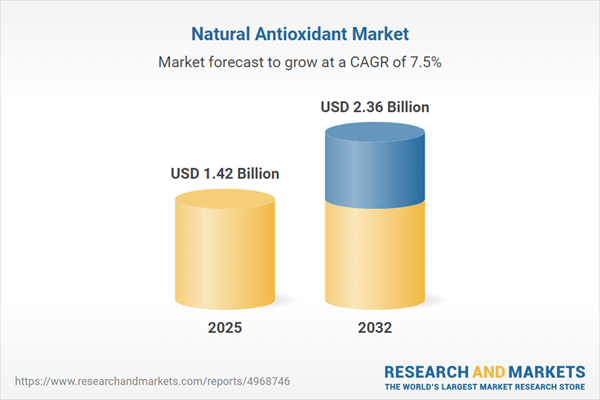Speak directly to the analyst to clarify any post sales queries you may have.
The natural antioxidant market is experiencing notable transformation as senior executives address growing regulatory requirements and heightened expectations around transparency in global supply chains. Navigating this landscape, leaders pursue innovation and operational agility to foster compliance and business resilience.
Market Snapshot: Natural Antioxidant Market Growth Outlook
The natural antioxidant market, currently valued at USD 1.32 billion in 2024, is projected to reach USD 1.42 billion in 2025 and forecast to achieve USD 2.36 billion by 2032, supported by a compound annual growth rate of 7.49%. This consistent upward momentum is driven by priorities such as clean labeling, regulatory tightening, and increased focus on traceability. Executive decision-makers are reinforcing strategic investments in next-generation extraction processes and establishing robust quality management frameworks. These actions ensure organizations remain responsive to evolving compliance standards and can swiftly adjust to dynamic shifts in industry and regulatory expectations.
Scope & Segmentation: Natural Antioxidant Market
A well-defined segmentation provides leadership teams with foundational insights for strategic planning, operational execution, and proactive risk mitigation, emphasizing both sustainability and regulatory compliance.
- Source Types: Animal-derived antioxidants focus on specialized nutrition niches; microbial origins provide manufacturing scalability; and plant-based sources—such as grape seed, rosemary, turmeric, and green tea—play a pivotal role in promoting eco-friendly practices and enabling cross-sector adoption.
- Application Sectors: Usage spans animal nutrition, food and beverage, cosmetics, dietary supplements, pharmaceuticals, and functional foods. This breadth gives manufacturers multiple entry points aligned with regulatory trends and the rising consumer preference for natural ingredients.
- Physical Forms: Natural antioxidants are supplied as liquid concentrates, essential and selected vegetable oils, and advanced powders. Processing methods, such as spray drying, enhance shelf stability, supporting quality assurance and broadening application flexibility.
- Extraction Methods: Companies employ enzyme-assisted, ultrasound- and microwave-assisted, solvent-based, and supercritical CO2 extraction to improve production efficiency, maintain high extract purity, and advance environmental objectives in line with industry sustainability targets.
- Regional Coverage: The market involves North America, Latin America, Europe, Middle East and Africa, and Asia-Pacific. Each region brings unique compliance challenges, with varying supply chain structures and differing risk profiles shaping geographic priorities and operational strategy.
- Competitive Landscape: Leading organizations—including Koninklijke DSM N.V., Archer Daniels Midland Company, BASF SE, DuPont de Nemours, Kemin Industries, Cargill, Lonza Group AG, Givaudan SA, Kerry Group, and Novozymes A/S—boost R&D, deepen collaborations, and increase operational resilience, ensuring they remain well-positioned to adapt to emerging industry requirements.
Key Takeaways for Senior Decision-Makers
- Enhancing transparency across ingredient sourcing and processing is central to meeting both stakeholder expectations and emerging audit standards.
- Strengthening quality management and end-to-end supply chain oversight supports brand reputation and minimizes exposure to regulatory and operational disruptions.
- Investing in advanced extraction technologies allows organizations to maximize efficiency and adaptability, ensuring readiness for shifts in technology or compliance priorities.
- Establishing deeper collaborations with suppliers and research organizations accelerates product launch cycles and underpins differentiation across target markets.
- Integrating analytics and blockchain technology enhances traceability and compliance processes, equipping teams to respond quickly to audits and complex customer requirements.
Tariff Impact: U.S. 2025 Tariff Measures
Pending changes in U.S. tariff regulations necessitate a greater emphasis on domestic manufacturing, expanded local partnerships, and product reformulation. Executives must prioritize proactive adjustments to supply chains to safeguard compliance and preserve uninterrupted market access while managing cost implications from shifting trade policy.
Methodology & Data Sources
Analysis is based on expert interviews with global logistics and compliance specialists, combined with established models such as SWOT, PESTEL, and value chain assessment. This methodology keeps insights closely aligned with the operational and strategic objectives of industry leaders seeking actionable intelligence.
Why This Report Matters
- Equips executive teams to enhance sourcing and compliance strategies as industry frameworks and standards evolve globally.
- Reveals critical risk areas and underscores the value of innovation, enabling improved process management and productive cross-functional collaboration.
- Provides practical recommendations for expanding market footprint, building strategic partnerships, and developing stable, sustainable international operations.
Conclusion
Industry leaders who prioritize transparency, cutting-edge extraction technology, and integrated supply chain management will be best placed to navigate regulatory demands and identify growth opportunities in an evolving natural antioxidant market.
Additional Product Information:
- Purchase of this report includes 1 year online access with quarterly updates.
- This report can be updated on request. Please contact our Customer Experience team using the Ask a Question widget on our website.
Table of Contents
3. Executive Summary
4. Market Overview
7. Cumulative Impact of Artificial Intelligence 2025
Companies Mentioned
The companies profiled in this Natural Antioxidant market report include:- Koninklijke DSM N.V.
- Archer Daniels Midland Company
- BASF SE
- DuPont de Nemours, Inc.
- Kemin Industries, Inc.
- Cargill, Incorporated
- Lonza Group AG
- Givaudan SA
- Kerry Group plc
- Novozymes A/S
Table Information
| Report Attribute | Details |
|---|---|
| No. of Pages | 197 |
| Published | October 2025 |
| Forecast Period | 2025 - 2032 |
| Estimated Market Value ( USD | $ 1.42 Billion |
| Forecasted Market Value ( USD | $ 2.36 Billion |
| Compound Annual Growth Rate | 7.4% |
| Regions Covered | Global |
| No. of Companies Mentioned | 11 |









